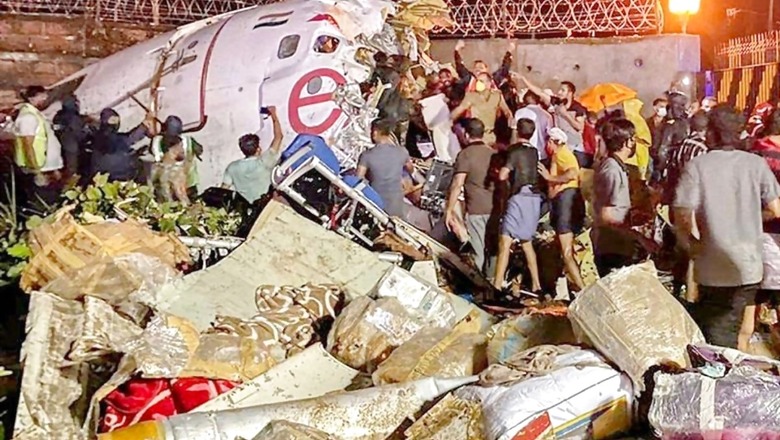
views
The sky had turned black.
Rain smeared the windows.
Air India Express Flight 1344 was midair, roaring through a thunderstorm toward the city of Kozhikode’s tabletop runway, which has a sudden drop-off at its end and was known to be potentially dangerous.
The pilot, a decorated military flyer, circled the airport once, then twice. With visibility so bad, he radioed the control tower to switch runways.
On his second attempt at landing Friday night, he apparently hit Runway 10 too late — more than a half-mile into the 1.6-mile strip — and with the wind at his back, which was exactly the scenario that Indian aviation experts had warned against.
“All the flights that land on Runway 10 in tail wind conditions in rain are endangering the lives of all on board,” said a report submitted to India’s civil aviation authorities in 2011.
The plane, a Boeing 737 returning to southern India from Dubai, United Arab Emirates, slid right off the rain-slicked runway, tumbled down a hillside and split in half. Indian officials say that 18 people, including both pilots, were killed and more than 150 were injured.
Looking at pictures of the wreckage taken on Saturday — with the skin of the plane ripped off and huge chunks of the cabin scattered across the mud — it is remarkable that more passengers weren’t killed.
The plane was carrying 190 people. Rescue crews, including many villagers, rushed to the crash site within minutes and pulled people out. The plane apparently never caught fire; the relentless rain may have dampened any sparks.
Survivors said they knew something was wrong the instant the wheels hit the ground.
“The plane landed at such a high speed and then braked really hard,” said Latheesh Muttooly, who was sitting by a window. “There’s usually a jerk when you land, but this was much harder, and then suddenly the plane started going faster.”
The overhead bins burst open. Heavy pieces of luggage fell on people’s heads.
“The next thing I heard was a loud crashing sound, the loudest sound I’ve ever heard,” Muttooly said.
His face smashed into the seat back in front of him, in Row 15, splitting open his chin. He was dazed.
“When I opened my eyes and looked around,” he said, “there was only one row in front of me.”
The front of the plane had torn off.
With the crash investigation just starting, Indian aviation officials are already beginning to pin the blame on the pilot, not the runway.
“The basic problem, as we understand it in this incident, is that on a runway of 8,500 feet, the plane landed after crossing one-third of the strip, beyond 3,000 feet,” Arun Kumar, India’s director general of civil aviation, said in an interview.
“What normally happens under such conditions is that the pilot does a go-round and either tries to land again or not land at all, given the weather conditions. Touchdown must happen within the first 500 feet of the strip.
“The rules of aviation are too well laid out,” Kumar added. “Either the pilot goes around or should not have landed at all.”
The crash was very similar to another, much deadlier Indian air accident at a tabletop runway in 2010, which had prompted a closer look at similar hilltop runways. India has four or five of them, officials said.
The 2010 crash involved the same kind of plane, a Boeing 737 belonging to the same airline, Air India Express, and a similar runway with steep gorges on each side. In that case, the aircraft skidded off a hill in Mangalore, fell into a valley and burst into flames. More than 150 people were killed.
After that, the Indian civil aviation ministry formed a safety advisory council that included aviation experts such as Capt. Mohan Ranganathan, a pilot who wrote the 2011 report warning that Kozhikode’s Runway 10 was dangerous. Some of his recommendations, like adding a safety zone at the end of the runway, were heeded, at least in part.
But on Saturday, Ranganathan said in an interview that he was dismayed to learn that the pilot tried to land in the very circumstances that he had warned about.
“Landing in rain with a tail wind is the most dangerous way you can think of landing,” he said, especially on Kozhikode’s Runway 10.
For a plane to crash, a bunch of things usually have to go wrong, which seems to have been the case in Flight 1344.
The runway was clearly a concern.
The captain, Deepak Sathe, a former Indian air force test pilot, seems to have misjudged the distance he needed to bring the plane to a halt.
And the weather was horrendous.
This is monsoon season, the time of year of lashing rains, and Sathe was trying to bring down a plane in the middle of a torrential downpour. For the past several days, Kerala state, where Kozhikode is and which has a long history of ties to the Persian Gulf, has been drenched.
India’s meteorological department had issued a red alert for several areas, including Kozhikode, on Friday. Earlier that same day more than 20 people were killed in a landslide in another part of the state after a hillside of rock and sludge crashed into a workers’ hostel on a tea plantation.
The way the announcements were made to the passengers didn’t help either, passengers said. The cabin crew used Hindi and English, India’s most widely spoken languages.
But this was a special repatriation flight, run by the Indian government to rescue citizens who had been stranded in the Persian Gulf during the coronavirus pandemic. Most passengers were working-class people (and their families) from Kerala who had been performing jobs such as clearing tables or driving trucks. They spoke Malayalam, Kerala’s tongue.
“They had no idea they had to keep wearing their seat belts,” said Riyas Madaparambathu, another passenger who had been working at a restaurant in Dubai. He said more lives might have been saved if the crew had made the announcements in Malayalam “so that everyone could have understood the instructions.”
On Saturday, officials said they had found the aircraft’s black box. Most of the surviving passengers remained in more than a dozen hospitals. Indian media reported that after some had tested positive for the coronavirus, survivors were not allowed to leave the hospitals just yet.
Many were clearly shaken up.
“The flight had been going fine,” said Muhammed Ali Meethal, who spoke by phone from his hospital bed. “The pilot announced that we were going to land. There was no warning or signal of any kind of impending doom.”
But after the plane skittered off the runway and down the hillside, he said. “There was a thud. And then a complete silence. I could smell death.
“I want to erase these memories,” he said, breaking into tears. “I need to keep the fear aside.”
Jeffrey Gettleman, Suhasini Raj and Shalini Venugopal [email protected] The New York Times Company




















Comments
0 comment